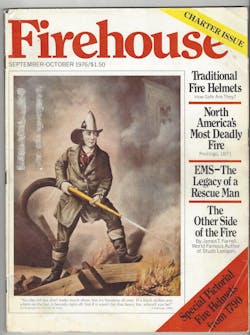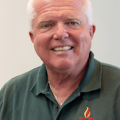40th Anniversary: Writing about Emergency Vehicle Operators
FDNY Firefighter Dennis Smith, with 13 years on the job, had a vision to start a monthly fire service publication for firefighters by firefighters. Born out of that vision, in October 1976, Firehouse Magazine became a reality. You may recall Smith wrote a bestselling book “Report From Engine Company 82,” which chronicled life as a South Bronx firefighter in the burn baby burn days of the 60s and 70s. In his first editorial—which was (and still is) titled “As Firehouse Sees It”—he stated, “We firefighters are simply not like other people. Our lives are different. Our families’ lives are different. We put our futures on the line when duty calls, and duty can call all of the time, 24 hours a day. Often it is our families who pay the price of our dedication.” He went on to say that, “Firefighting is not a nine-to-five, five day a week job. It is a life commitment, and Firehouse Magazine is dedicated to serving the people who make that commitment: firefighters, their families and their friends.” Lastly, he said, “Firehouse has a commitment to inform and tell it like it is.” As you thumb through the pages of Firehouse Magazine today, that same commitment to inform and “tell it like it is” has been, and always will be, evident.
Firehouse Magazine had quite a different look back then. First, a majority of the ads were not from the fire service. Only four apparatus manufacturers had ads in the charter issue, and only one is still in business. The only recognizable column and author in that first issue was Hal Bruno, who wrote Fire Politics, and did so for decades until his death.
As you can see from the photo, I have a copy of the charter issue of Firehouse Magazine, and I have saved every issue since.
I started as a volunteer firefighter in 1974, and every year at Christmas time, I would get subscriptions for several of the monthly fire service publications, including Firehouse. I read each magazine from cover to cover, and could not wait until the next issue arrived in the mail. In 1981, I was appointed to the FDNY and started my career in July. I had driven fire apparatus in the volunteers since 1976, and then in 1986, I was driving a ladder truck in the Bronx—the same borough that Dennis Smith had worked. I continued to read each magazine from cover to cover.
Each summer, the magazines would come out with the previous year’s line-of-duty-death statistics. For years, I would read about the 20–30 percent of firefighters who were dying in vehicle accidents while responding to and returning from alarms. Yet as I read my magazines, nobody wrote anything about this topic. Killing firefighters in fire apparatus had become our best-kept dirty little secret.
When I was driving for Ladder Company 56 in the Bronx, we were averaging 5,000 runs per year. In quarters with Ladder 56 was the Seventh Division with Deputy Chief Vincent Dunn, another long-time Firehouse contributor and a dear friend, but more importantly, a mentor to me who convinced me to write my first article for WNYF (With New York Firefighters).
I met Firehouse’s then-Editor-in-Chief, Harvey Eisner, who would come to visit Chief Dunn often. I then had the idea that someone should do something about the emergency vehicle line-of-duty-death rate, showing that we were needlessly losing too many firefighters to traffic accidents. Finally, I got to sit down at the firehouse on a Sunday afternoon with Chief Eisner and basically went through a very informal interview and pitched my idea to have an Emergency Vehicle Operators column. Harvey thought that this was a great idea, so in January 1994, my first EVOC column appeared in Firehouse Magazine.
Since that time, this column has become a regular feature of the magazine and one of its mainstays for which I am truly grateful. To date, no one else writes with regularity about emergency vehicle operations in any fire service platform anywhere. Why has this column become so successful and one of the most read features in the magazine? Because of you, our loyal readers.
It’s funny to think back to my original meeting with Harvey. He asked me to type up column headings (topics) as ideas for future columns. I had 53. I wondered what would happen when I ran out of ideas. Well, I came to find out that, thanks to you, our readers, I would never run out of ideas. When I talk to you at trade shows or on phone calls or more recently over email, you share your experiences and ideas to then be shared with other firefighters through my column. You entrust me and Firehouse to share your experiences, even sometimes devastating ones that are very personal and painful, with brother and sister firefighters like you. And of course, this was never to demean any firefighter or any fire department, but rather to share these experiences in the spirt of learning and education to perhaps prevent some other firefighter from enduring the same pain and heartache.
Perhaps the best example was a column that appeared in February 1996, titled “In One Split Second Lives were Changed Forever.” The article highlighted the journey of Gerry Brown, who was in a near-fatal apparatus accident at an intersection in Bowling Green, KY. This was perhaps one of the most powerful columns to ever appear in this space. Brown went on to become chief of department in Bowling Green, and we became friends, and on several occasions, I went to see Chief Brown and to train Bowling Green firefighters.
Another reason that this column has been a success is our advertisers. Advertisers offer the financial resources necessary to maintain this platform of learning and sharing. Without our advertisers, we simply would not exist. So thank you to all our loyal advertisers who support myself and Firehouse Magazine to make this column a reality.
Finally, thank you to the staff at Firehouse Magazine, who work tirelessly each month to produce a top-notch, relevant magazine and who make my column look and read better than it should.
I count my blessings each and every day that I was given this awesome responsibility and opportunity to write for the very magazine that I worshiped as a young volunteer firefighter. No one, least of all my college English professor, would have thought that I would have gotten published in a national fire publication. I feel especially honored to help fulfill the vision that the first Firehouse Magazine Editor-in-Chief Dennis Smith had 40 years ago—to produce a magazine for firefighters by firefighters, a magazine that was designed to inform, tell it like it is and make a difference. Happy 40th anniversary, Firehouse Magazine! May you have many more.
About the Author
Michael Wilbur
MICHAEL WILBUR, who is a Firehouse contributing editor, retired as a lieutenant in FDNY, where he was last assigned to Ladder Company 27 in the Bronx. He has served on FDNY's Apparatus Purchasing Committee and consults on a variety of apparatus-related issues around the country. Wilbur is a member of the Firehouse Hall of Fame. For further information, access his website at www.emergencyvehicleresponse.com.

